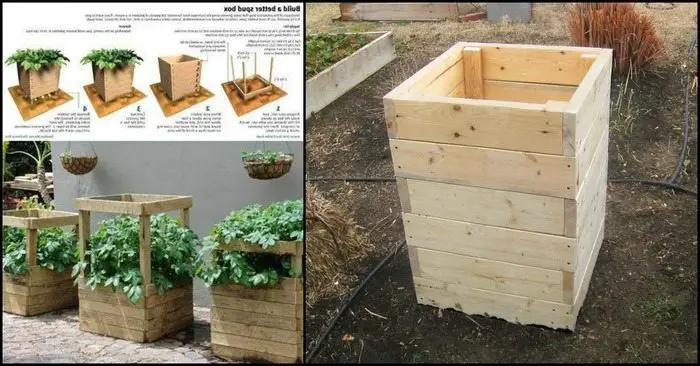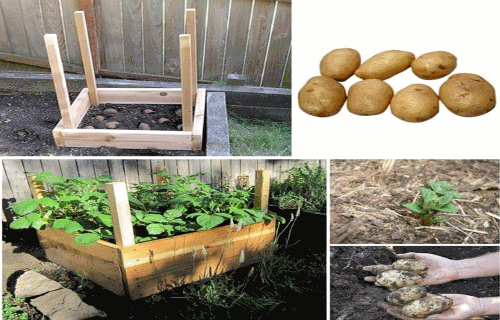You don’t need a lot of space to grow a substantial amount of potatoes, and using a box is far easier than growing them in the ground. You have a couple of options to consider in terms of how to construct the box that will allow you to take advantage of different harvesting methods. Let’s take a look at the basic design and how easy it is to construct.
Building the Base
The first step is to determine how big you want the box to be. Try to make it at least two feet square in order to be able to harvest enough potatoes to make this project worth your while. Two foot boxes are also easier to manage throughout the growing process and during the harvest. Try to work with 2 x 6 planks as this dimension will make layering and removing sections easier over time as well, however, 2 x 4 boards can get the job done as well.
Build the base by screwing two screws to the ends of the wood on each side of the box. Use one layer of plank to create the base board. The next step is to create four vertical structural support beams that will be used to attach additional sections of wood as the potatoes grow. Take four 2 x 2 pieces of wood that are at least three feet tall and temporarily stick them into the dirt along the inside corners of the base box. You don’t want to screw these supports into the base box. Instead, add another section of the wood frame and attach that one to the supports. Make sure that you lift the supports so the bottom is flush against the bottom of the base board before you screw them into the second section.
Building the Box

You will want to layer the box as the potatoes grow, so cut the pieces of wood to size and make the frames. Set them aside for use later. Put your soil into the base board and fill it just above the point where the second section meets the base. Plant your potatoes, water and watch them grow. As the vines get taller and reach about 12 inches above the soil, add another frame without screwing it to the support beams. Add another layer of dirt. However, you want to make sure that you only cover about a third of the plant so you won’t stunt its growth. Keep repeating this process as the potatoes grow until you’ve reached the top of the tower.
WOODWORKING VIDEOS
Harvesting the Potatoes
By this time, the potatoes on the bottom will be ready for harvest and much larger than the ones on top. You have a couple of options to consider at this point. First, you can either lift each segment off of the tower and remove all of the potatoes at once. Or, you can remove one of the planks from the base board by unscrewing it and harvesting the potatoes from this gap. If you chose to use this approach, the soil will collapse as you harvest the potatoes. All you need to do is replace the board and add more soil on top.
The first approach works well at the end of the growing season when you want to harvest all of the potatoes. The second approach can work well throughout the growing season and give you a steady supply of potatoes during this time. No matter how you decide to harvest the potatoes, this box gives you the flexibility to manage growth. It is also sturdy enough to be used year after year as long as you choose wood that is not prone to rot and decay.
Try this for yourself and see how this simple system can give you a fantastic amount of potatoes in a small space. Being able to use it year after year reduces the amount of time, effort and material that you will need in the beginning of each season. Feel free to improvise and make the boxes bigger or smaller based on your needs, but chances are that you will be able to get at least a hundred potatoes out of each box.
Discover how to survive: Most complete survival tactics, tips, skills and ideas like how to make pemmican, snow shoes, knives, soap, beer, smoke houses, bullets, survival bread, water wheels, herbal poultices, Indian round houses, root cellars, primitive navigation, and much more at: The Lost Ways
The Lost Ways is a far-reaching book with chapters ranging from simple things like making tasty bark-bread-like people did when there was no food-to building a traditional backyard smokehouse… and many, many, many more!
Here’s just a glimpse of what you’ll find in The Lost Ways:
From Ruff Simons, an old west history expert and former deputy, you’ll learn the techniques and methods used by the wise sheriffs from the frontiers to defend an entire village despite being outnumbered and outgunned by gangs of robbers and bandits, and how you can use their wisdom to defend your home against looters when you’ll be surrounded.
Native American ERIK BAINBRIDGE – who took part in the reconstruction of the native village of Kule Loklo in California, will show you how Native Americans build the subterranean roundhouse, an underground house that today will serve you as a storm shelter, a perfectly camouflaged hideout, or a bunker. It can easily shelter three to four families, so how will you feel if, when all hell breaks loose, you’ll be able to call all your loved ones and offer them guidance and shelter? Besides that, the subterranean roundhouse makes an awesome root cellar where you can keep all your food and water reserves year-round.
From Shannon Azares you’ll learn how sailors from the XVII century preserved water in their ships for months on end, even years and how you can use this method to preserve clean water for your family cost-free.
From Susan Morrow, an ex-science teacher and chemist, you’ll master “The Art of Poultice.” She says, “If you really explore the ingredients from which our forefathers made poultices, you’ll be totally surprised by the similarities with modern medicines.” Well…how would you feel in a crisis to be the only one from the group knowledgeable about this lost skill? When there are no more antibiotics, people will turn to you to save their ill children’s lives.
If you liked our video tutorial on how to make Pemmican, then you’ll love this: I will show you how to make another superfood that our troops were using in the Independence war, and even George Washington ate on several occasions. This food never goes bad. And I’m not talking about honey or vinegar. I’m talking about real food! The awesome part is that you can make this food in just 10 minutes and I’m pretty sure that you already have the ingredients in your house right now.
Really, this is all just a peek.
The Lost Ways is a far–reaching book with chapters ranging from simple things like making tasty bark-bread-like people did when there was no food-to building a traditional backyard smokehouse… and many, many, many more!
And believe it or not, this is not all…
Books can be your best pre-collapse investment.
Carnivore’s Bible (is a wellknown meat processor providing custom meat processing services locally andacross the state of Montana and more. Whether your needs are for domestic meator wild game meat processing)
The Lost Book of Remedies PDF ( contains a series of medicinal andherbal recipes to make home made remedies from medicinal plants and herbs.Chromic diseases and maladies can be overcome by taking the remediesoutlined in this book. The writer claims that his grandfather was taughtherbalism and healing whilst in active service during world war twoand that he has treated many soldiers with his home made cures. )
Easy Cellar(Info about building and managing your root cellar, plus printable plans. The book on building and using root cellars – The Complete Root Cellar Book.)
The Lost Ways (Learn the long forgotten secrets that helped our forefathers survive famines,wars,economic crisis and anything else life threw at them)
LOST WAYS 2 ( Wordof the day: Prepare! And do it the old fashion way, like our fore-fathers did it and succeed longbefore us,because what lies ahead of us will require all the help we can get. Watch this video and learn the 3 skills that ensured our ancestors survival in hard times offamine and war.)


